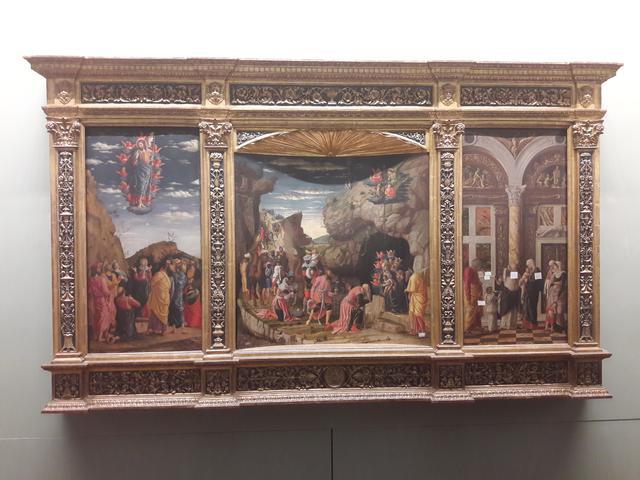Triptych of the Uffizi

The Uffizi Triptych is a tempera painting on one panel by Andrea Mantegna, dating from around 1460. The work is composed of three panels brought together only in the 19th century, whose true cohesion as a triptych is questioned by many art historians. . It is the Ascension of Christ, the Adoration of the Magi and the Circumcision.
Most scholars consider these three paintings to be part of the decoration of the private chapel of the Marquis Ludovico III Gonzaga in the castle of San Giorgio di Mantova, to which two letters dated April 1464 sent by Mantegna to the Marquis and the vasarian mention of "would refer to a tablet [by Mantegna], in which there are stories of figures that are not very large but very beautiful [...] in the castle of Mantua, for the chapel."
Others (such as Fiocco), unable to explain the work's arrival in Florence, place it as a work made in Tuscany during one of the artist's two trips, dated 1466 and 1467. However, stylistic reasons link the work past the artist's Paduan period (completed in 1459), rather than the Mantuan phase.
In any case, the oldest work confirmed with certainty dates back to 1587, when it was dismembered in Valle Muggia, near Pistoia, among the properties of Don Antonio de' Medici. In 1632, through hereditary passages, the work entered the grand ducal collections, where it was already dismembered and with the Adoration of the Magi attributed to Botticelli. The reconstruction of the work took place in 1827, with the new carved and gilded Neo-Renaissance frame that compensates for the differences between the central table (almost square and slightly concave) and the side tables.
Most modern critics emphasize the inconsistency of this assembly, emphasizing the differences, as well as in format and form, also of configuration and pictorial quality, especially between the Circumcision and the other two tables. Roberto Longhi doubted that the three tables had been conceived as a unit and hypothesized that they had a different function within the chapel, which also included the table of the Death of the Virgin in the Prado, including its appendage cut off by the coronation. of the tablet in an indefinite period with Christ with the animation of the Virgin. According to him, the Circumcision was to replace the Death of the Virgin panel when it was decided to limit the "Stories" to the life of Christ alone.
© Tourblink